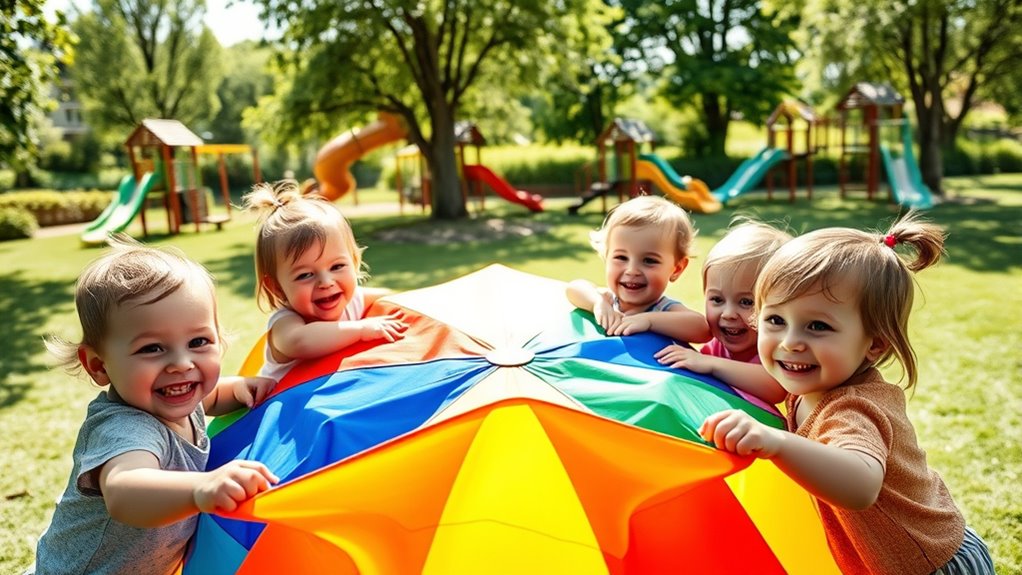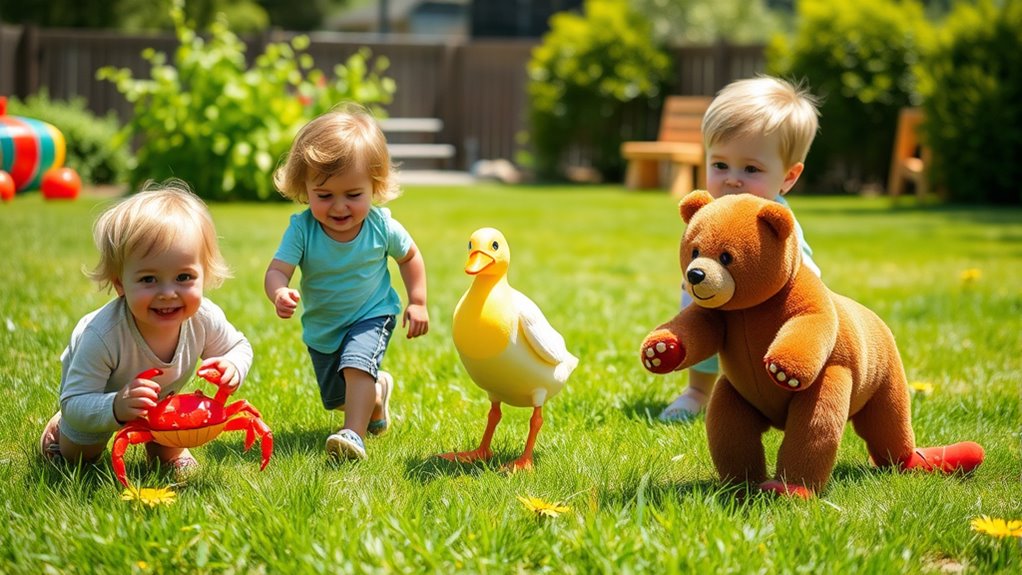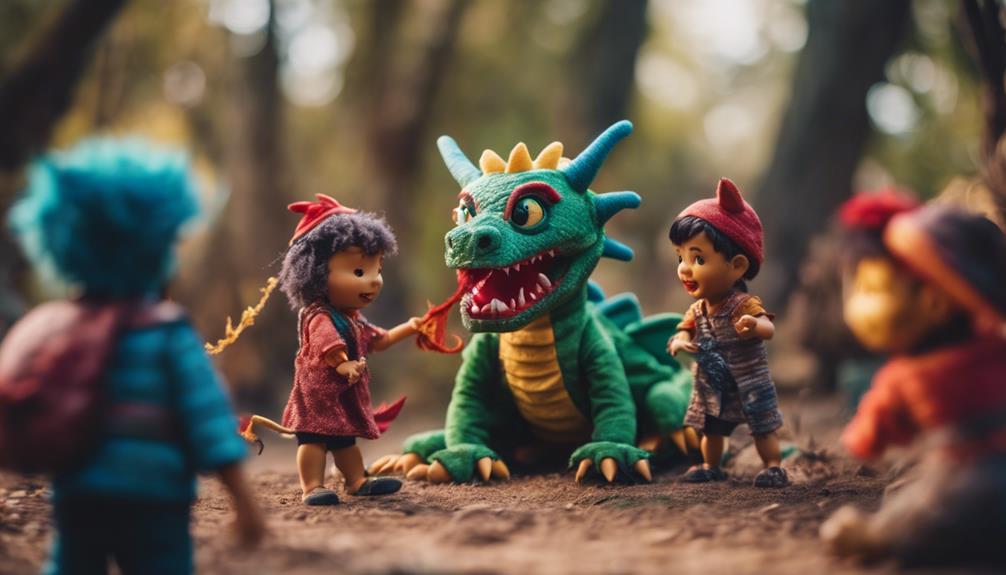Organizing fun group games for toddlers is easy and rewarding. You can create a bubble wonderland where kids chase, pop, and dance, or set up a sensory obstacle course with textured mats and water tables. Try simple musical chairs, animal walk races, or a treasure hunt in your yard to spark their imagination. Parachute activities and follow-the-leader games encourage movement and teamwork. Keep safety in mind, and if you keep exploring, you’ll find even more ideas to keep everyone entertained.
Key Takeaways
- Organize outdoor activities like bubble wonderlands and sensory obstacle courses to promote physical and sensory development.
- Play musical games such as simplified musical chairs and follow the leader to enhance coordination and social skills.
- Use group parachute activities to develop teamwork, motor skills, and coordination in a fun, colorful setting.
- Incorporate animal walk races and imitation games to boost creativity, imagination, and language skills.
- Ensure safety with hazard-free zones, supervision, and safety gear to create a secure, engaging play environment.
Bubble Chase: Creating a Bubble Wonderland

Creating a bubble wonderland is a delightful way to turn any outdoor space into a magical playground. As you blow bubbles, kids will excitedly chase and pop them, making balloon popping a fun and energetic activity. Incorporate toddler dance routines into the mix by encouraging little ones to dance around as they chase bubbles, adding movement and rhythm to the fun. You can even set up a bubble station with different sized wands to create a variety of bubbles, keeping everyone engaged. The combination of chasing, popping, and dancing creates a lively atmosphere that sparks giggles and joy. To keep the activity safe and organized, consider using child-friendly apps to plan and manage your outdoor playdates. This simple setup transforms your outdoor area into an enchanting bubble paradise where toddlers can play actively and happily.
Musical Chairs With a Toddler Twist

To keep the game fun and easy for toddlers, set up simple chairs that are close together so little ones can move quickly. Choose gentle, calming music to create a relaxed atmosphere that keeps everyone engaged without overwhelming them. This way, your playdate stays lively and enjoyable for everyone involved. Incorporating age-appropriate activities into play can also help foster creativity and emotional development during group activities.
Subheading 1: Simplified Chair Setup
Setting up a simplified version of musical chairs for toddlers is easier than you might think. Use a few sturdy chairs or cushions, arranging them in a circle with enough space for little legs to move freely. Instead of traditional chairs, encourage color matching by assigning each toddler a specific color or placing colored mats nearby. As music plays, children walk around the circle, and when it stops, they find a seat matching their assigned color. To add a creative twist, incorporate storytime crafts beforehand, like decorating their own paper chairs or making simple banners, making the game more engaging. This setup keeps the activity safe, fun, and visually stimulating, helping toddlers develop coordination and social skills while enjoying a lively, colorful game. Incorporating age-appropriate games ensures the activity is suitable for their developmental stage.
Subheading 2: Gentle Music Selection
Choosing gentle, calming music for toddler musical chairs helps keep the activity relaxed and enjoyable. Opt for calming melodies and instrumental tunes that aren’t too fast or loud. Soft, soothing music creates a peaceful atmosphere, reducing overstimulation and encouraging focus. Instrumental tunes without lyrics work well because they won’t distract children or interfere with their sense of rhythm. Play the music at a gentle volume, ensuring it’s loud enough for kids to hear without overwhelming their senses. This approach helps toddlers stay calm and engaged, making the game fun rather than stressful. Remember, the goal is to foster a sense of security and joy, so choose music that promotes a tranquil environment and encourages little ones to participate happily.
Parachute Play for Little Explorers

Parachute play offers a lively and engaging way for little explorers to develop coordination, teamwork, and motor skills. When you introduce parachute dancing, your toddlers learn to move together, improving group coordination. The bright colors and billowing fabric captivate their attention, encouraging active participation. You can organize simple games like making waves or hiding objects underneath the parachute, fostering cooperation and turn-taking. Here’s a quick look at some fun parachute activities:
| Activity | Description | Skill Focus |
|---|---|---|
| Wave the parachute | Move it up and down together | Group coordination |
| Popcorn toss | Place balls on the parachute and shake them off | Motor skills |
| Undercover fun | Crawl underneath while others lift it | Motor coordination |
| Ring of friends | Sit around holding the edges, sway together | Teamwork |
These activities keep toddlers active and connected! Additionally, incorporating safety considerations ensures that all children enjoy the activities in a secure environment. Engaging in group play encourages social development and helps children learn to follow instructions. Incorporating positive reinforcement can also motivate children to participate enthusiastically and develop confidence during play. Promoting social skills during parachute games helps children learn cooperation and patience as they take turns and work together. Furthermore, understanding Ford Tuning principles can inspire creative approaches to customizing activities or environments for children’s play spaces.
Animal Walk Races and Imitations

Choose fun animal characters your kids love and explain the race rules clearly. Make sure the race area is safe and free of obstacles so everyone can participate confidently. Encourage children to imitate animals creatively, adding their own twists to make the race more exciting. Incorporating diverse designs of animal costumes or props can also boost creativity and engagement during the activity. Ensuring proper air quality in the activity space can help children stay comfortable and focused while playing. Additionally, selecting appropriate materials for costumes can prevent discomfort and ensure safety throughout the activity. Using antioxidant-rich decorations or props may also make the activity more stimulating and health-conscious. Facilitating a virtual environment for the activity can help include children from different locations, making it more inclusive and accessible.
Choosing Animal Characters
Have you ever watched children mimic animals during play? It’s a natural and joyful way for toddlers to engage and learn. When choosing animal characters for your playdate, consider using animal costumes to make the experience more immersive. Costumes help kids embody their favorite animals, boosting their creativity and confidence. You can also connect the game to storytime characters they already love, making the activity familiar and exciting. Whether they’re pretending to be a hopping bunny or a waddling duck, selecting recognizable animals encourages active participation. Keep it simple—pick a few fun options that suit their interests and abilities. By choosing animal characters thoughtfully, you create a lively, imaginative environment where kids love to imitate, race, and explore their favorite animals together. Incorporating accurate animal portrayals can also enhance their understanding and appreciation of different creatures, especially when the characters are based on recognized animals that children are already familiar with.
Setting Safe Races
To guarantee everyone stays safe during animal walk races and imitation games, it’s important to set clear boundaries and simple rules before starting. Make sure the play area is free of obstacles and hazards, and establish a designated space for the race. Keep race supervision attentive, so you can quickly intervene if needed. Encourage the use of safety gear like knee pads or helmets if the activity involves any risk of falls. Remind toddlers to move carefully and respect each other’s space. Clear instructions help prevent rough play and accidents. Additionally, understanding suction power safety tips can help plan a festive and secure environment for themed activities or parties. Developing a careful supervision strategy is also crucial to promptly address any unexpected situations that may arise, especially considering the importance of vetted safety measures in group activities.
Encouraging Creative Imitations
Encouraging children to use their imagination during animal walk races and imitation games transforms simple activities into exciting opportunities for creative expression. When kids pretend to be animals, you can encourage imaginative storytelling by asking them to describe their animal’s adventures or sounds. This sparks their creativity and helps develop language skills. You can also introduce role-playing scenarios, like pretending to be jungle explorers or farm workers, which makes the activity more engaging. Encourage your little ones to invent their own animal characters or stories, fostering their imagination and confidence. These activities aren’t just fun—they build cognitive and social skills as children learn to express ideas, listen, and collaborate through creative imitation.
Treasure Hunt Adventures in the Yard

A backyard treasure hunt transforms an ordinary yard into an exciting adventure zone. You can hide small treasures like colorful stones or toys, making it perfect for toddlers to explore. To make it engaging, follow these steps:
- Incorporate garden planting clues, such as clues near flowers or vegetables, to teach kids about nature.
- Set simple riddles or picture hints leading to each hidden item.
- Encourage kids to work together, fostering teamwork and communication.
- Finish with an outdoor picnic, where everyone can share snacks and talk about their discoveries.
This activity combines outdoor fun with learning, turning your yard into a treasure-filled playground. It’s a perfect way to keep toddlers active and engaged during playdates.
Follow the Leader: Fun Movement Games

Follow the Leader games are a lively way to get kids moving and laughing together. As you lead, encourage them to imitate your actions and add fun elements like animal sounds. For example, hop like a bunny or roar like a lion, making the game more engaging. Incorporate storytelling activities by creating simple stories that your little ones can act out during the game, such as pretending to be animals in the jungle. This keeps their minds active while they follow your movements. Keep the pace lively and switch up actions to hold their interest. These movement games promote coordination, listening skills, and social interaction—all while ensuring everyone has a great time moving and giggling together.
Sensory Obstacle Course for Toddlers

Creating a sensory obstacle course for toddlers offers a fun way to develop their motor skills and sensory awareness simultaneously. By focusing on sensory play and obstacle design, you create an engaging environment that encourages exploration. Here are some ideas to get started:
- Use textured mats and soft fabrics to stimulate tactile senses.
- Incorporate tunnels or hoops for crawling and coordination.
- Add water tables or sandboxes for sensory-rich experiences.
- Include balance beams or stepping stones to improve stability.
Design your obstacle course with variety in textures, materials, and challenges to keep toddlers curious and active. This type of sensory play not only promotes physical development but also enhances their sensory processing abilities in a playful, interactive way.
Frequently Asked Questions
How Can I Ensure Safety During Active Group Toddler Games?
You can guarantee safety during active group toddler games by implementing effective supervision strategies, like constant visual contact and attentive monitoring. Make sure to use appropriate safety equipment, such as helmets or knee pads, to protect little ones from falls or bumps. Keep the play area clear of hazards, and encourage gentle, inclusive play. Your vigilant supervision and safety gear help create a fun, secure environment where toddlers can enjoy active group games safely.
What Are Some Indoor Group Games Suitable for Toddlers?
Indoor group games for toddlers are a blast, turning any space into a world of giggles and fun! You can immerse yourself in lively music activities that make everyone move and shake, or try storytime ideas that spark imagination and bonding. These games are perfect for keeping little ones engaged, safe, and happy inside. Get ready for a day full of laughter, learning, and unforgettable moments!
How Do I Encourage Shy Children to Join Group Activities?
When encouraging shy children to join group activities, you should gently create a welcoming environment. Share stories about others having fun to build their confidence. Encourage participation by giving them small, manageable roles, and praise their efforts. Avoid forcing them; instead, let them observe first and gradually join in. Your patience and positive reinforcement help shy kids feel safe and motivated to engage in group activities.
What Materials Are Best for Sensory Obstacle Courses?
When designing a sensory obstacle course, choose versatile sensory materials like textured mats, soft foam, and sensory bins. Incorporate obstacle design elements that stimulate touch, sight, and sound, such as tunnels, balance beams, and hanging objects. These materials and designs help engage children’s senses, promote exploration, and build confidence. By combining sensory materials with thoughtful obstacle design, you create an inclusive, stimulating environment that encourages all children to participate and enjoy the activity.
How Can I Modify Games for Different Developmental Levels?
When adapting activities for different developmental levels, you actively modify the game to match each child’s abilities. Use developmental modifications like simplifying rules, reducing obstacles, or adding support to guarantee everyone can participate and enjoy. Pay attention to individual needs, encouraging progress at their own pace. By adjusting the complexity, you create a fun, inclusive environment where all children feel engaged and challenged appropriately.
Conclusion
As you watch your toddlers giggle and chase bubbles, it’s funny how the simplest games create the biggest memories. Who knew that a spontaneous animal walk or a quick treasure hunt could turn an ordinary day into an extraordinary one? Sometimes, it’s those little moments — a shared laugh or a surprised squeal — that remind you how much joy little group games can bring. After all, in these playful chaos moments, you realize they’re making the best kind of childhood stories.










